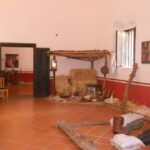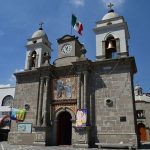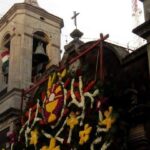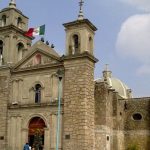Acopilco, often still called San Lorenzo Acopilco for the parish is one of the five original villages of Cuajimalpa. A rugged high altitude town, it’s cool, if not cold, just about year round. At 3,350 meters above sea level, it’s the highest town and the westernmost of pueblos within Mexico City.
The town is centered around a complex that includes both the Temple and the formed by the Temple and Chapel of San Lorenzo Acopilco. These were damaged during the 2017 earthquakes and recently restored. The complex includes the shared atrium and a small civic kiosk.
According to the historian Otoniel Contreras Esquivel, the lands were originally occupied during a 13th-century expansion of Malinalco, (south and east in Mexico State). This was credited to a prince named Copil. The name derives from that territorial takeover, and thus means “Place of the waters of Copil.”
Construction is said to have begun on the chapel in 1536. The octagonal church was built using riverstones. The vaulted ceiling, damaged in 2017, was added later with help from the Carmelites from Desierto de los Leones. The drive is a bit more than 20 minutes to the east.
The parish church was begun in 1771. Today, it’s most famous for having hosted the Zapatistas who used it as a military barracks during the Revolution. The bell tower dates from 1977.
From the center of the town, neighborhoods spread out to the south and west. La Pila is the highest and youngest of these. Begun only about 75 years ago, today it’s a neighborhood, but still a very distinct and mountainous place to visit.
 55 5811 0250
55 5811 0250
 https://www.facebook.com/AcopilcoXIII
https://www.facebook.com/AcopilcoXIII

Nearest at 1.66 kms.

Nearest at 2.58 kms.

Nearest at 2.61 kms.

Historical and charming San Pedro Cuajimalpa is high in the mountains of Mexico City - and always remarkable.

A history of ranching as rugged as its tall trees and mountainous landscape.

One of the most rugged old towns of Cuajimalpa, this one's worth a visit just for the views.

Among the rugged hills of Cuajimalpa, one of the original towns carries on, often in spectacular fashion.